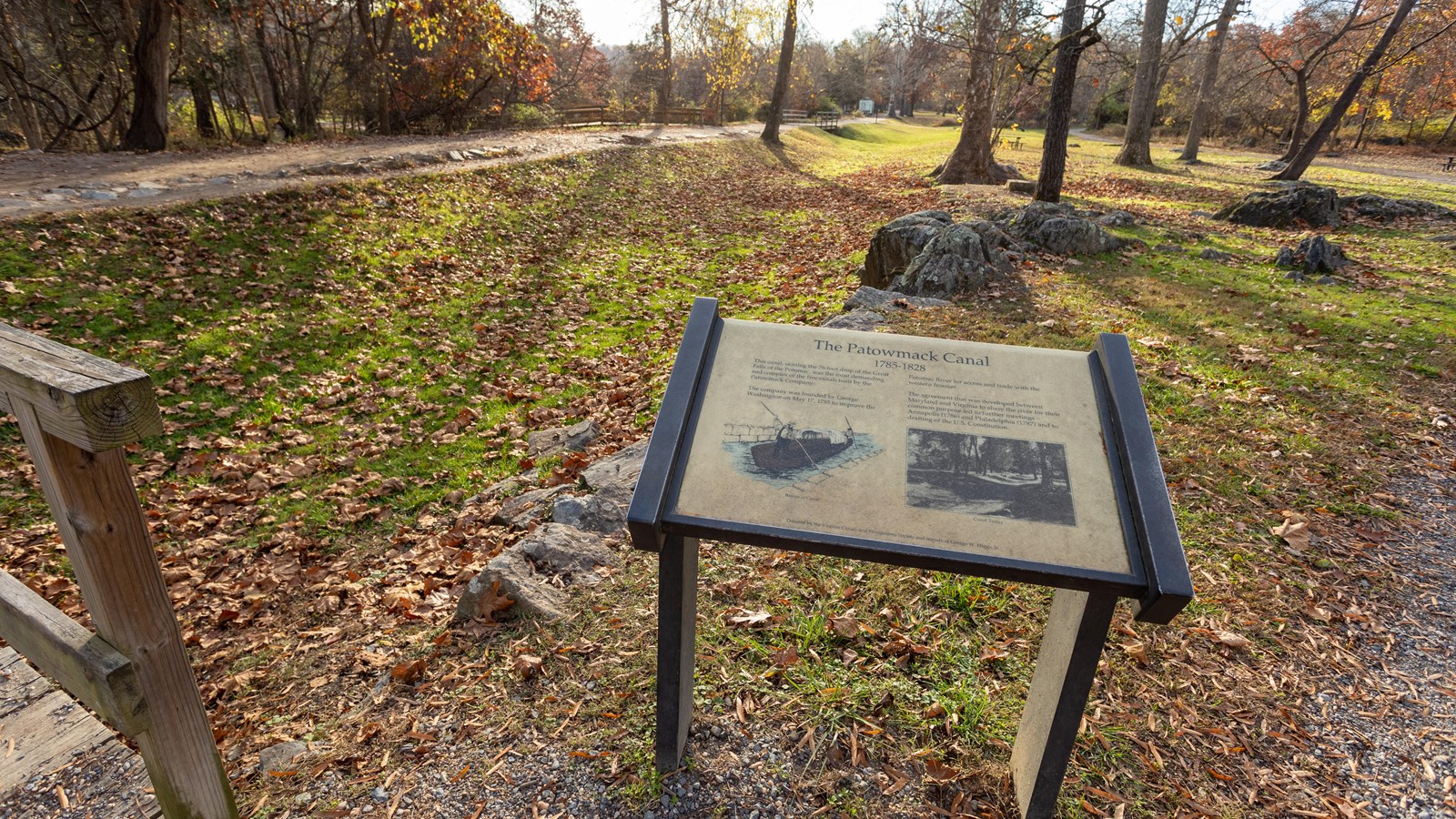Last updated: September 27, 2024
Place
Potowmack Canal

NPS / Claire Hassler
Historical/Interpretive Information/Exhibits
The Potowmack Canal is the best preserved segment of a river navigation system constructed between 1786 and 1802 by the Potowmack Canal Company. Although it is among the earliest and best surviving examples of an early American canal system, its national importance relates not to its engineering or commercial success, but instead to its direct connections to important public questions of the day and to the formative events that led to the development of the United States Constitution. Among those questions were the debate over federal authority to regulate interstate commerce, the need for internal improvements to link the country, and the role government would play in accomplishing such projects.
Visionary American leaders including George Washington and James Madison played pivotal roles in both the Potowmack Canal Company and the formation of the nation. Meetings initiated as part of the formation of the Potowmack Canal reinforced the need to clarify and strengthen the role of the central government in trade and commerce. Trade conferences that took place at the beginning of the Potowmack Canal venture directly influenced James Madison and others to create the 1787 Constitutional Convention.
Prior to the American Revolution, George Washington wished to develop transportation routes from the eastern seaboard to the vast western territories. After years of petitioning, his dreams were finally realized in the 1780s. Along with James Madison, Washington proposed a canal as one element of an overall strategy to unite the new country. By January 1785, both Maryland and Virginia had passed the legislation needed to build a canal.
In March 1785, representatives from Maryland and Virginia successfully negotiated a broad agreement for the joint use of the Potomac River and Chesapeake Bay at George Washington's Mount Vernon. The report of the meeting also called for an annual conference on commercial matters between Maryland, Virginia and other states.The first of these meetings occurred the following year at the Annapolis Convention, where several states called for a constitutional convention to draft a cohesive federal constitution. The Potomac improvements, which would be organized by the new Patowmack Company, thus helped crystallize sentiments for national unity.
In May 1785, Washington was elected the first president of the Patowmack Company. Its goal was to reduce navigation hazards in the river and its tributaries, for example, by clearing out sandbars and rubble and by blasting channels in shallow places. Workers constructed five “skirting” canals at places where obstacles were too large to be removed and the river was not navigable. The canal at Great Falls is the best preserved example of these by-passing waterways.
The work was difficult and dangerous. The company hired free people, but also utilized indentured servants and enslaved people living in the vicinity. Washington often traveled to the construction sites to observe and direct the process. In 1789, he resigned from the company to become the first president of the United States.
Floods and accidents plagued the construction of locks at Great Falls and delayed the opening of the canal by years. Even after the canal was fully operational in 1802, fluctuations in weather and water level drastically affected operations. The erratic and limited operating schedule discouraged traffic, which limited income from tolls, the only source of revenue.
Near the canal construction, Revolutionary War hero, “Light Horse” Harry Lee, the father of Robert E. Lee, founded Matildaville (named after his wife). Here the Patowmack Company stationed its headquarters and created housing for workers. In the little town, one could find a market, gristmill, sawmill, foundry, inn, and ice house. Boardinghouses and other small homes also emerged to meet the increasing demands of canal patrons.
Thousands of boats headed to Georgetown used the skirting canals to successfully transport goods such as flour, whiskey, tobacco, and iron. Vessels heading upstream, which was much more difficult, brought manufactured goods such as cloth, firearms and hardware towards Cumberland. The downstream trip took three to five days. The upstream journey, which required laborers to pole against the current, lasted ten to twelve days.
During the 1820s, Virginia and Maryland politicians advocated for the construction of another canal to connect the Chesapeake Bay and the Ohio River. In 1825, the Chesapeake and Ohio Canal (also known as the C&O Canal) was chartered. Shortly thereafter, in 1828, the Patowmack Company closed. The new canal company continued to operate the Patowmack Canal until 1830. In that year, the company dismantled the working parts of the locks, thereby rendering it nonfunctional. Since that time, nature has taken its course with the derelict canal, although major elements of it survive as ruins. Matildaville likewise declined, although some of its structures continued to be used on a sporadic basis. The traces of the town can still be seen on the landscape today.
As the predecessor to the C&O Canal, the Patowmack Canal helped usher the new country into an era of bustling transportation and economic expansion. The canal was intimately linked with important public issues of its day: Federal authority over matters pertaining to interstate commerce, the need for the creation of internal improvements to link distant parts of the new nation, and the role of government in accomplishing such projects.
For more information visit The Potowmack Canal
National Historic Landmark Nomination of the Potowmack Canal Historic District.
National Historic Landmarks (NHLs) are historic places that possess exceptional value in commemorating or illustrating the history of the United States. The National Park Service’s National Historic Landmarks Program oversees the designation of such sites. There are just over 2,500 National Historic Landmarks. All NHLs are also listed in the National Register of Historic Places.
